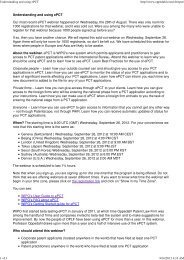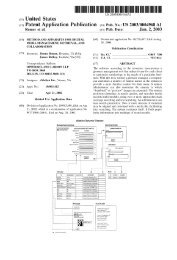Polaroid Corp. v. Eastman Kodak Co. - Oppedahl Patent Law Firm LLC
Polaroid Corp. v. Eastman Kodak Co. - Oppedahl Patent Law Firm LLC
Polaroid Corp. v. Eastman Kodak Co. - Oppedahl Patent Law Firm LLC
Create successful ePaper yourself
Turn your PDF publications into a flip-book with our unique Google optimized e-Paper software.
Intellectual Property Library ISSN 1526-8535<br />
Although <strong>Polaroid</strong> had no firm plans to introduce the OneStep in 1977, the elements of a<br />
low-priced model were being explored. This is the reason <strong>Polaroid</strong> was able to respond<br />
so quickly to the Handle. (TR 234-35; 341-42). Mr. Bassett, <strong>Polaroid</strong>'s sales forecaster,<br />
recommended to Mr. Wensberg that <strong>Polaroid</strong> "[i]ntroduce an under $25.00 SX-70 type<br />
camera early in 1977." (DF 70,076B). Mr. Wensberg also advocated a product priced<br />
under $50. (DF 20,279). Throughout the infringement period, whenever <strong>Polaroid</strong><br />
introduced lower-priced models, <strong>Kodak</strong> executives felt they had to respond because the<br />
<strong>Polaroid</strong> cameras at comparable prices usually had more features. (TR 7816-30).<br />
Moreover, some price cuts <strong>Polaroid</strong> instituted were deceptive as the cheaper product<br />
often offered fewer features. The 1978 Pronto RF price cut for example, occurred after<br />
<strong>Polaroid</strong> removed the camera's tripod mount and timer.<br />
<strong>Polaroid</strong> claims it was unable to raise its film price as high as it would have liked because<br />
of competition with <strong>Kodak</strong>. Yet, well before <strong>Kodak</strong>'s entry, <strong>Polaroid</strong> knew that "the<br />
strongest reason consumers do not buy a <strong>Polaroid</strong> camera is due to our film price." (DF<br />
61,606, Tab 9, see also Tab 11). Both companies priced their film almost identically<br />
throughout the infringement period. In only one instance was there was a nine month<br />
delay between when <strong>Polaroid</strong> raised its film prices and <strong>Kodak</strong> followed. <strong>Kodak</strong> also<br />
initiated several price hikes which <strong>Polaroid</strong> followed. Mr. Brewer stated:<br />
From my personal perspective, we basically set our prices predicated upon what we felt<br />
would have impacted both our volume and margins; and the <strong>Kodak</strong> film price, to my<br />
recollection, they were normally quite responsive to whatever we did, in terms of if we<br />
increased our price, the sense was that <strong>Kodak</strong> increased their prices. So the sensitivity<br />
level in pricing was not very intense at all in the film area.<br />
(DF 70,007A). Still, <strong>Polaroid</strong> claims it feared raising prices because of <strong>Kodak</strong>.<br />
From about 1980 on the foremost concern of <strong>Polaroid</strong> executives in pricing film was the<br />
competition with conventional photography, specifically, 35mm cameras and film. In<br />
1981, Mr. Booth reported to <strong>Polaroid</strong>'s board that "[the] relative price of an instant<br />
picture to a conventional picture is a major concern" and that "if we raise our prices much<br />
more than five percent per year we will widen the ratio of instant to conventional and it is<br />
already very high." (DF 10,413 at 0838-39). In 1982, <strong>Polaroid</strong>'s Director of Strategic<br />
Planning wrote a series of memoranda concluding that the widening gap between the<br />
price per print of instant and conventional photography "had a substantial negative effect<br />
on <strong>Polaroid</strong>'s share of the amateur photographic market." (DF 61,606, Tab 6). Many<br />
other <strong>Polaroid</strong> reports, memos and studies report the concern of the relative film prices<br />
between instant and conventional. ( See, e.g., DF 61,606 Tab 22, Tab 27). This<br />
constraint on film pricing would have been present without <strong>Kodak</strong> and I believe<br />
<strong>Polaroid</strong>'s response would have been present without <strong>Kodak</strong> and I believe <strong>Polaroid</strong>'s<br />
response would have been the same.<br />
<strong>Co</strong>nclusion<br />
After reviewing all the evidence in this regard, I find that even in <strong>Kodak</strong>'s absence<br />
<strong>Polaroid</strong> would have lowered camera prices, introduced the lower-priced OneStep and<br />
felt constrained regarding film prices just as it did historically. <strong>Polaroid</strong> claims that it<br />
would not have lowered prices but the proof is to the contrary. The decline in instant film<br />
prices cannot be laid at <strong>Kodak</strong>'s door. The market was changing, influenced both by the<br />
competition from conventional photography and changing consumer perception of instant<br />
<strong>Co</strong>pyright 2003, The Bureau of National Affairs, Inc. Reproduction or redistribution, in<br />
whole or in part, and in any form, without express written permission, is prohibited except<br />
as permitted by the BNA <strong>Co</strong>pyright Policy. http://www.bna.com/corp/index.html#V<br />
36





